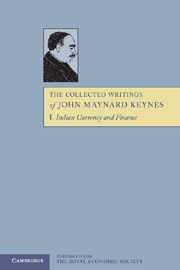Book contents
- Frontmatter
- Contents
- General introduction
- Editorial foreword
- Preface
- Dramatis personae
- 1 THE PRESENT POSITION OF THE RUPEE
- 2 THE GOLD-EXCHANGE STANDARD
- 3 PAPER CURRENCY
- 4 THE PRESENT POSITION OF GOLD IN INDIA AND PROPOSALS FOR A GOLD CURRENCY
- 5 COUNCIL BILLS AND REMITTANCE
- 6 THE SECRETARY OF STATE'S RESERVES AND THE CASH BALANCES
- 7 INDIAN BANKING
- 8 THE INDIAN RATE OF DISCOUNT
- Index
- Chart showing the rate of discount at the Presidency Bank of Bengal
4 - THE PRESENT POSITION OF GOLD IN INDIA AND PROPOSALS FOR A GOLD CURRENCY
Published online by Cambridge University Press: 05 November 2012
- Frontmatter
- Contents
- General introduction
- Editorial foreword
- Preface
- Dramatis personae
- 1 THE PRESENT POSITION OF THE RUPEE
- 2 THE GOLD-EXCHANGE STANDARD
- 3 PAPER CURRENCY
- 4 THE PRESENT POSITION OF GOLD IN INDIA AND PROPOSALS FOR A GOLD CURRENCY
- 5 COUNCIL BILLS AND REMITTANCE
- 6 THE SECRETARY OF STATE'S RESERVES AND THE CASH BALANCES
- 7 INDIAN BANKING
- 8 THE INDIAN RATE OF DISCOUNT
- Index
- Chart showing the rate of discount at the Presidency Bank of Bengal
Summary
The Fowler Committee of 1898 avowed themselves in favour of the ultimate establishment of a gold currency in India as well as a gold standard. Paragraph 54 of their Report runs as follows:
We are in favour of making the British sovereign a legal tender and a current coin in India. We also consider that, at the same time, the Indian mints should be thrown open to the unrestricted coinage of gold on terms and conditions such as govern the three Australian branches of the Royal Mint. The result would be that, under identical conditions, the sovereign would be coined and would circulate both at home and in India. Looking forward as we do to the effective establishment in India of a gold standard and currency based on the principles of the free in-flow and out-flow of gold, we recommend these measures for adoption.
The first part of their proposal was carried out immediately and, in 1899, British gold was declared legal tender at the rate of a sovereign to 15 rupees. It appeared at first as if their further object of a gold currency might soon be attained also. The principle of minting gold in India was accepted both by the secretary of state and by the viceroy's council, and in 1900 Sir Clinton Dawkins actually announced that it had been decided to constitute a branch of the mint at Bombay for this purpose.
- Type
- Chapter
- Information
- The Collected Writings of John Maynard Keynes , pp. 45 - 71Publisher: Royal Economic SocietyPrint publication year: 1978



